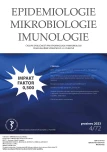Analysis of meningococcal vaccine uptake in patients with invasive meningococcal disease, Czech Republic, 2006–2022
Authors:
P. Křížová 1; Z. Okonji 1,2; M. Honskus 1,2
Authors‘ workplace:
Národní referenční laboratoř pro meningokokové nákazy, Centrum epidemiologie a mikrobiologie, Státní zdravotní ústav, Praha
1; 3. lékařská fakulta Univerzity Karlovy, Praha
2
Published in:
Epidemiol. Mikrobiol. Imunol. 72, 2023, č. 4, s. 243-247
Category:
Short Communication
Overview
In 2006–2022, 958 cases of invasive meningococcal disease (IMD) were reported to the surveillance programme in the Czech Republic, of which 21 (2.19%) had a history of vaccination with one of the meningococcal vaccines. Data analysis shows that these vaccines provide a very good protection against IMD. It was found that vaccinated patients with IMD either were not vaccinated against the causative serogroup and/or did not receive a booster dose. The results of this analysis show the benefit of both vaccines available in the Czech Republic: recombinant vaccine containing meningococcal serogroup B antigens (MenB vaccine) and tetravalent conjugate vaccine containing antigens of four meningococcal serogroups A, C, W, Y (A, C, W, Y conjugate vaccine). The results also show the benefit of meningococcal vaccine booster doses and the need for giving MenB vaccine to young children as early as possible.
Sources
- Česká vakcinologická společnost ČLS JEP. Doporučení a stanoviska [online]. 2023. Dostupné na www: https://www.vakcinace. eu/doporuceni-a-stanoviska.
- Národní referenční laboratoř pro meningokokové nákazy. Vybrané publikace [online]. Dostupné na www: https://szu.cz/ odborna-centra-a-pracoviste/centrum-epidemiologie-a-mikrobiologie/oddeleni-bakterialnich-vzdusnych-nakaz/narodni-referencni-laborator-pro-meningokokove-nakazy/vybrane-publikace-nrl-pro-meningokokove-infekce/.
- Křížová P, Honskus M, Okonji Z, et al. Analýza epidemiologických a molekulárních dat surveillance invazivního meningokokového onemocnění v České republice za období 1993–2020. Epidemiol Mikrobiol imunol, 2022;71(3):148–160.
- McNamara LA, Topaz N, Wang X, et al. High Risk for Invasive Meningococcal Disease Among Patients Receiving Eculizumab (Soliris) Despite Receipt of Meningococcal Vaccine. MMWR Morb Mortal Wkly Rep, 2017;66(27):734–737, doi: 10.15585/mmwr. mm6627e1.
- PubMLST database. Public databases for molecular typing and microbial genome diversity. Dostupné na www: https://pubmlst.org/organisms/neisseria-spp/.
- Brehony C, Rodrigues CMC, Borrow R, et al. Distribution of Bexsero® Antigen Sequence Types (BASTs) in invasive meningococcal disease isolates: Implications for immunisation. Vaccine, 2016;34(39):4690–4697, doi: 10.1016/j.vaccine.2016.08.015.
- Rodrigues CMC, Jolley KA, Smith A, et al. Meningococcal Deduced Vaccine Antigen Reactivity (MenDeVAR) Index: a Rapid and Accessible Tool That Exploits Genomic Data in Public Health and Clinical Microbiology Applications. J Clin Microbiol, 2020; 59(1):e02161–20, doi: 10.1128/JCM.02161-20.
- Soler-Garcia A, Fernández de Sevilla M, Abad R, et al. Meningococcal Serogroup B Disease in Vaccinated Children. J Pediatric Infect Dis Soc, 2020;9(4):454–459, doi: 10.1093/jpids/piz071.
- Üçkardeş D, Göknar N, Kasap N, et al. Meningococcemia in a vaccinated child receiving eculizumab and review of the literature. Turk J Pediatr, 2023;65(1):129–134, doi: 10.24953/turkjped.2022.190.
- Ladhani SN, Campbell H, Amin-Chowdhury Z, et al. Timing of meningococcal vaccination with 4CMenB (Bexsero®) in children with invasive meningococcal group B (MenB) disease in England. Vaccine. 2022;40(10):1493–1498, doi: 10.1016/j.vaccine.2021.12.010.
Labels
Hygiene and epidemiology Medical virology Clinical microbiologyArticle was published in
Epidemiology, Microbiology, Immunology

2023 Issue 4
Most read in this issue
- Pathogenesis of infections caused by SARS-CoV-2
- Rabies in the world and the Zero by 30 strategy
- HIV-1 subtypes distribution and resistance to ART in HIV-infected persons in Slovakia (2019–2021)
- Risk of Streptococcus pneumoniae-associated haemolytic uraemic syndrome in industrialised nations: a systematic review of the literature
